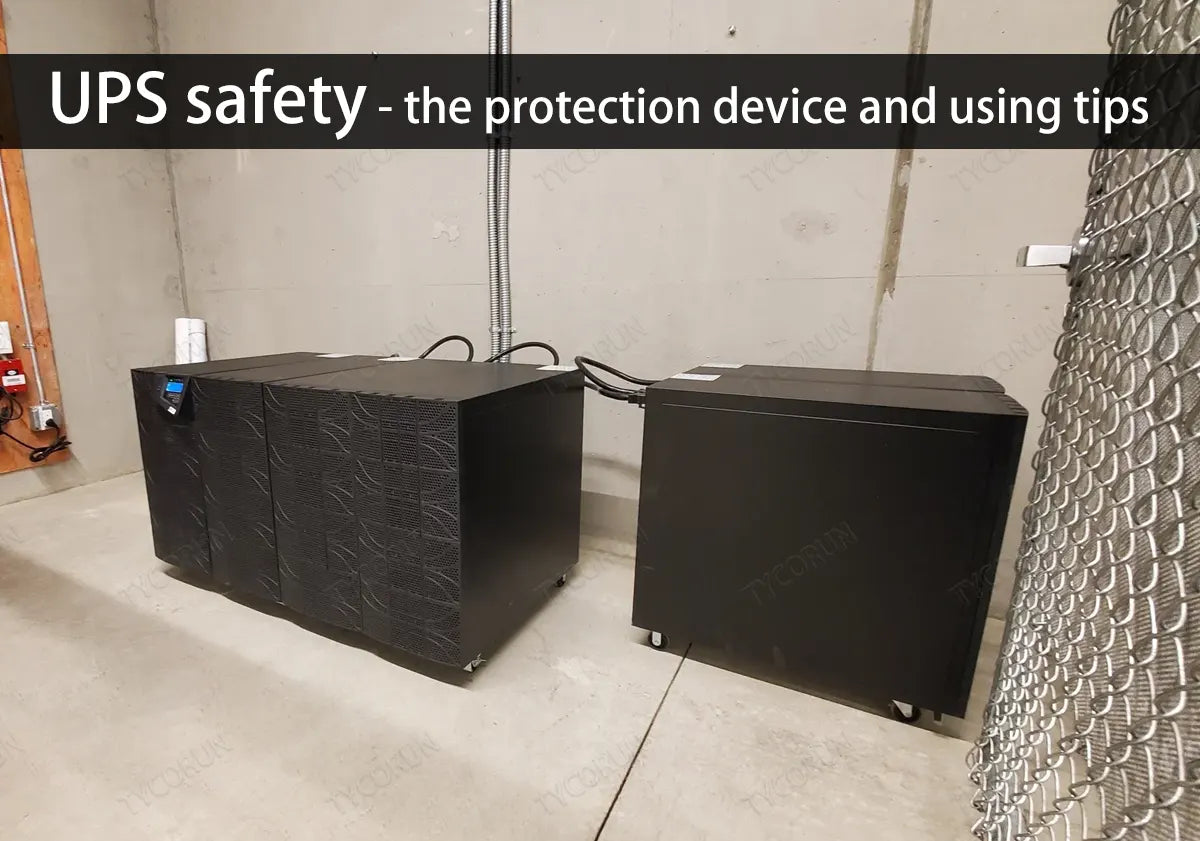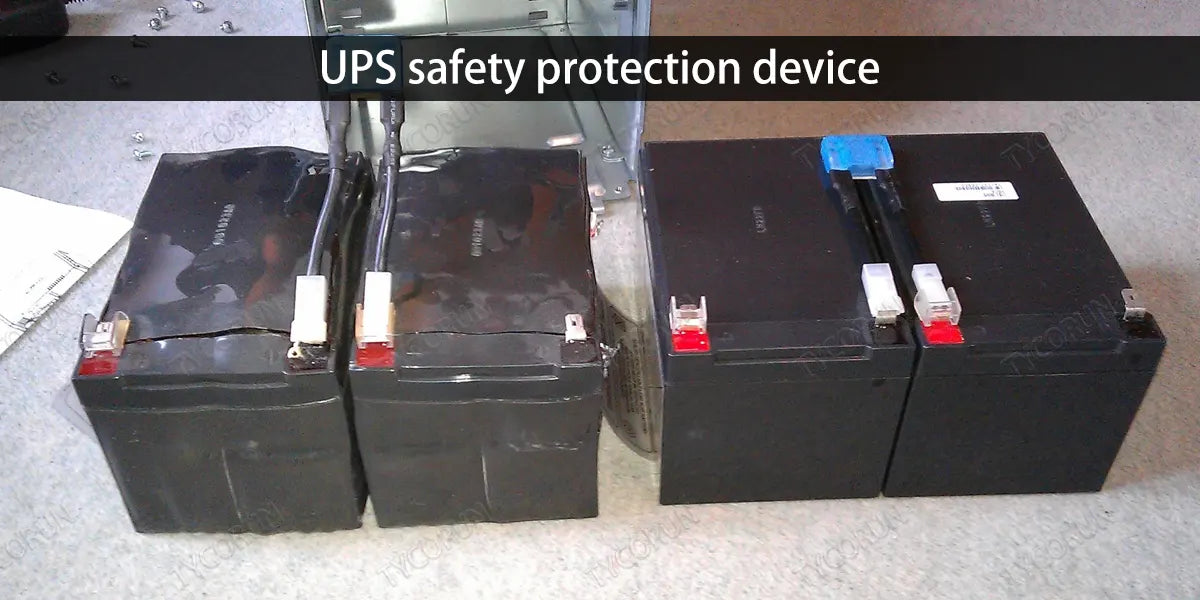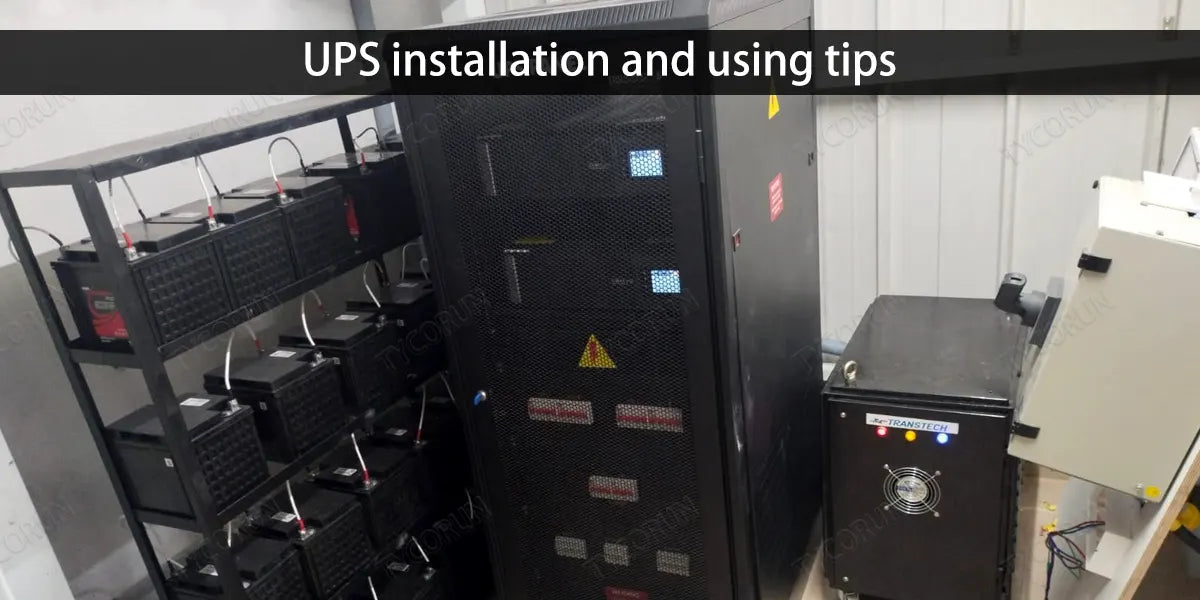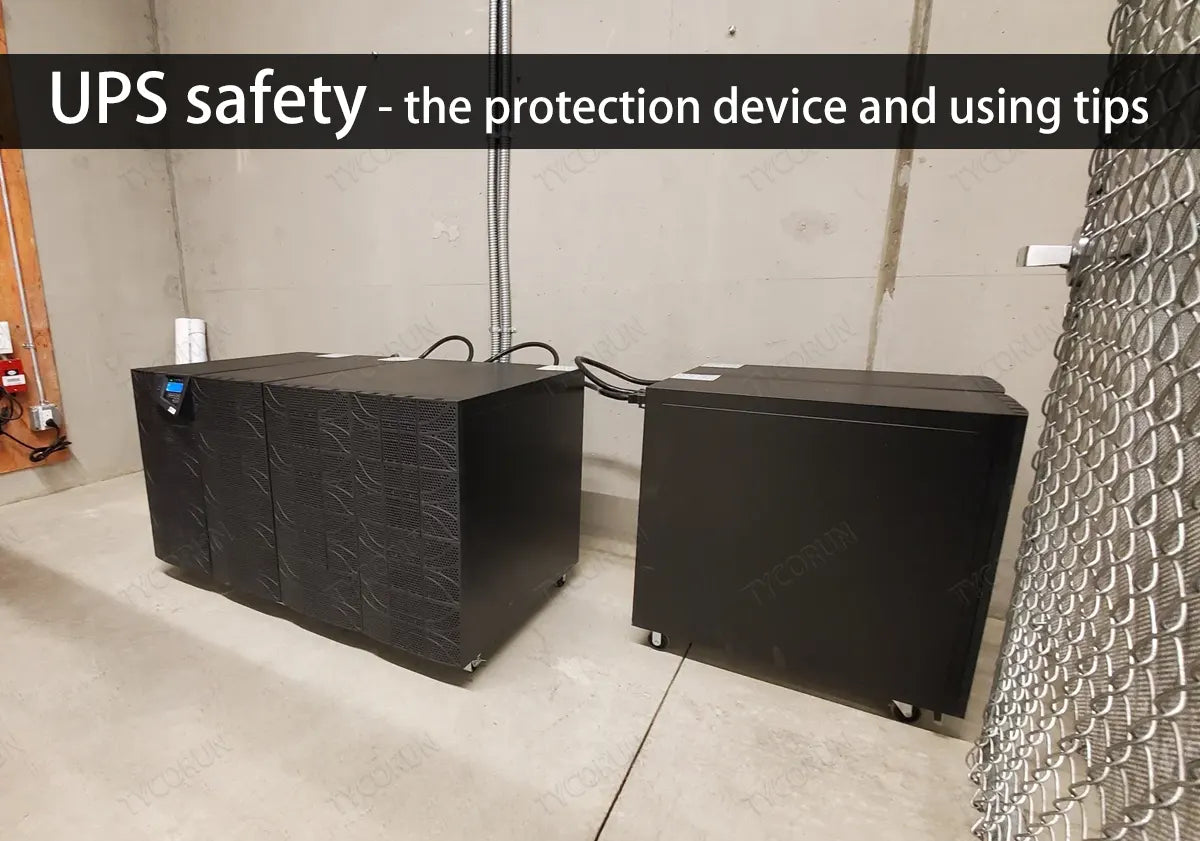
With the development of social informatization, data center security is particularly important. Once a fire occurs, it will cause huge losses to the data center, and many data center fires are caused by UPS (uninterruptible power supply) fires. This article will describe the protection of UPS safety and related safe use suggestions.
Main content:
1. Cause of UPS fire
UPS is widely used in many fields of life and work, as an uninterruptible power supply that mainly used to provide power protection for important loads, including eliminating various power disturbances in the power grid, UPS is different from inverters. For more details of inverter details, you can click to check TYCORUN 2000 watt inverter pure sine wave and 3000 watt solar inverter.
Before getting to UPS safety tips, let’s have a look at what’s causing UPS fire:
① The virtual connection of the cable joint causes excessive contact resistance. After the temperature rises, the contact surface is seriously oxidized, which in turn causes the contact resistance to increase. Eventually, it will cause UPS safety problems such as electrical sparks or even arcing, igniting nearby combustibles and causing a fire.
② A short-circuit accident occurs in the back-end lines, switches or loads of the UPS power supply, results in UPS safety problems, causing a fire inside the UPS or the explosion of high-power components.
③ Some places where UPS are installed have serious dust. The dust is sucked into the UPS machine through the UPS cooling fan. When the concentration reaches a certain value, it will cause a fire inside the UPS, affecting UPS safety.
④ Changes in the working environment of the UPS battery pack (such as temperature, humidity, etc.) can cause battery failure and cause fires.
⑤ Problems such as battery shell deformation, electrolyte leakage, insufficient capacity, uneven battery terminal voltage, etc. may cause fires, affecting UPS safety.
So, how to prevent UPS fire accidents and guarantee UPS safety?

2. UPS safety protection device
When the UPS power supply is in use, it must have a set of UPS safety protection devices. The UPS safety protection devices mainly have the following requirements:
① The UPS power supply must have protection devices that match the protection components. There are monitoring devices such as appropriate indicators and/or alarms at appropriate locations, which can be operated automatically or manually to maintain the battery power generation system working within the allowable limit.
② The UPS safety protection device designed and installed to the UPS should also be reliable and suitable for various environments. The installation location should meet maintenance and testing requirements. And in the state of protecting, other functions should be distinguished from it, showing the independence of the protection function. In order to obtain appropriate and reliable protection, appropriate design principles should be followed. In particular, this design principle should include fail-safe modes, redundant design, diverse design and self-diagnostic.
③ In the design stage of the UPS safety protection device, integrated measurement, regulation and control devices (such as overcurrent cut-off switch, temperature limiter, differential pressure switch, flow meter, time delay relay, overspeed monitor or other monitoring devices) to prevent dangerous overloading of the equipment.
④ The design and installation of protection devices with measuring functions should be able to handle foreseeable operating requirements and applications under special conditions. Where necessary, the accuracy of the readings and the suitability of the device can be checked. This type of device can determine a comprehensive UPS safety factor for the alarm threshold outside the UPS safety warning line. In particular, the operating conditions of the device installation and possible deviations in the measurement system should be considered.

3. UPS selection and power distribution design
- UPS selection
The selection of UPS should be determined according to the requirements of the types of load, load capacity, allowed power interruption time, etc., and should comply with the following regulations:
① UPS should be used for capacitive and resistive loads for UPS safety;
② When powering computers, the rated output power of the UPS device should be greater than 1.2 times the sum of the rated power of all computer equipment. When powering other electrical equipment, the rated output power of the UPS device should be 1.3 times the maximum load;
③ The capacity of the battery pack should be selected by the user according to the power supply interruption time requirements of the specific project to ensure UPS safety;
④ The working conditions of UPS should be considered based on the continuous working system;
⑤ There should be selective coordination between protection devices at all levels of the UPS power distribution system.

- Input power
The AC input power of the UPS should meet the following requirements:
① The UPS should be powered by two power supplies, and harmonic control measures should be taken on the power supply side for UPS safety;
② The AC power supply of UPS should not be powered by the same transformer and busbar as other impact loads;
③ In the TN-S power supply system, the AC input end of the UPS should be equipped with an isolation transformer or a special transformer. When the isolation transformer at the output end of the UPS is in the TN-S or TT grounding form, the neutral point should be grounded.
4. UPS installation and using tips
- Power wiring
The connection between the UPS and the main power supply should be safe and reliable, and the connection device should meet one of the following connection methods:
①Have terminal blocks permanently connected to the main power supply;
②Have a non-detachable power cord that is permanently connected to the power supply or connected to the power supply with a plug;
③Have an appliance plug connected to a detachable power cord.
If the UPS has more than one connection to the main power supply (such as different voltage/frequency power supplies, or as a backup power supply), the connection methods should meet all of the following conditions for UPS safety:
① Provide independent connection methods for different circuits;
② Misinserting the power plug connection device will cause danger, interchange is strictly prohibited;
③Prevent operators from touching dangerous exposed parts when one or more connectors are disconnected.

- Battery connection
For UPS safety, LFP battery electrodes and battery connectors should be easily accessible to facilitate tightening with tools; contacts, connections and wiring must be protected against the effects of ambient temperature, humidity, gas, steam and mechanical pressure; batteries should be protected against electrolytes leakage and dispersion.
- Accessory connection
The specifications and models of the rectifier device, inverter device, static switch, and energy storage device of the UPS should meet the design requirements. The internal wiring should be correct and not loose, and the fasteners should be complete.
For UPS safety, the polarity of the UPS should be correct, and the test and adjustment of various technical performance indicators such as input and output protection system actions at all levels and output voltage stability, waveform distortion coefficient, frequency, phase, and static switch action should meet the requirements of product technical documents. When on-site final testing is used instead of factory testing, test adjustments should be made according to the product technical documents and should comply with the requirements of the design documents.
- Insulated from ground
The insulation resistance value of the input terminal and output terminal of the UPS to the ground should not be less than 2MΩ. The insulation resistance value of the UPS connection and outlet wires between the lines and the ground should not be less than 0.5MΩ. The system grounding connection method of UPS output should meet the design requirements for UPS safety.
- Wiring fireproof
Insulated wires and cables leading in or out of the UPS main circuit and control insulated wires and cables should be protected by metal sleeves, or mineral insulated non-combustible cables should be used.
When laid in parallel in cable brackets, ladder racks, trays or wire troughs, the separation spacing should meet the design requirements; the shielding sheaths of insulated wires and cables should be connected to the ground reliably, with complete fasteners, and should be connected to the grounding trunk line nearby.
- Feed protection
The UPS should be equipped with backfeed protection for UPS safety. Under normal conditions or when the AC input power is lost and a unit failure occurs in components, there should be no risk of electric shock at the input end of the backfeed protection device.
- Overload protection
The UPS should support overload protection function. When an overload occurs within the specified range, the UPS should work normally and alarm with sound and light signals. When the overload duration or intensity exceeds the specified value, the UPS should automatically shut down the output and have corresponding protection. It should start normally after the overload disappears.

- Surge and short circuit protection
UPS with power less than 10kV·A should have both surge and short-circuit protection functions. UPS with power greater than or equal to 10kV·A should have instantaneous overcurrent and short-circuit protection functions. When instantaneous overcurrent and short-circuit overload occur, the UPS should absorb transient overcurrent and short-circuit current limiting and operate normally.
When transient overcurrent occurs and the short circuit cannot be eliminated, the UPS should automatically shut down the output and provide corresponding protection to avoid further danger. When turned on again, the UPS should be able to turn on normally by resetting or replacing the pre-specified fuse.
- Electric shock protection
As one of the key factors affecting UPS safety, UPS components with dangerous voltage or energy levels and components that can cause personal injury should be fixed, isolated or added with protective devices. Components that require live inspection, reset, adjustment, and repair should be installed to ensure that components that may be touched during electrical maintenance will not cause electric shock hazard to workers.
- Emergency shutdown switch
The UPS should be equipped with an emergency shutdown switch (or a terminal connected to a remote emergency switch device) to prevent the UPS from continuing to supply power to the load in any operating mode.
- Disconnect device
The UPS should be equipped with a disconnecting device for UPS safety. If the disconnecting device disconnects the neutral line, it should disconnect all phase lines at the same time; for a three-phase UPS, the disconnecting device should disconnect the power supply and all phase lines at the same time; for UPS powered by IT systems, the disconnect device should be four-pole and capable of disconnecting all phase and neutral wires.
- Grounding protection
The UPS should be equipped with protective grounding and be reliably connected to the protective grounding terminal. The UPS should be equipped with overcurrent, short circuit and ground fault protection for input and output circuits, and should be marked. The protection device is an integral part of the equipment and a part of the building facilities. The UPS protection device should be installed in the battery room. The number of overcurrent protection devices is 1 and the number of grounding protection devices is 1 or 2n.
- Battery stand
The battery should be installed vertically. The installation should use a steel frame structure platform, which can be stacked in multiple layers. It should be convenient for battery installation, maintenance and replacement. The platform should be fixed on a ceramic tile or cement platform. The height of the platform should be 150mm-300mm. The overall height of the platform should not exceed 1500mm.
The assembly of the platform or base should be horizontal and vertical, with complete fasteners, and allowable deviations in horizontality and verticality, and it should not be greater than 1.5‰. The structural stability should be such that it will not cause UPS safety problem and harm to operators and maintenance personnel. The stand or base should not be used to carry current. There should be insulation measures between the battery and the ground.
- Assembly principles
Batteries from different manufacturers, capacities, models, and periods are strictly prohibited from being assembled in the same DC power supply system. Batteries of different levels of old and new are strictly prohibited from being mixed and assembled in the same DC power supply system. The cable connecting the UPS to the battery such as 18650 battery or 21700 battery should be the cable configured by the UPS manufacturer to guarantee UPS safety.
If the manufacturer does not configure the cable, the cable with the size specified in the installation instructions should be used. Batteries on the same floor or on the same platform should be connected by insulated or sheathed connecting strips, and batteries on different floors or on different platforms should be connected by cables.
- Battery identification
The battery should have the following clear information that is easy to understand, which should be positioned so that maintenance personnel can easily see it during maintenance:
① Battery type, number of cells or units in the battery pack;
② The total nominal voltage of the battery pack;
③ Warning signs clearly indicate the energy or electric shock and chemical hazards of the equipment, as well as the maintenance and disposal requirements specified in the relevant instructions.
Related posts: 12v 100ah lithium ion batteries, 1000w inverter, Home solar power system
















